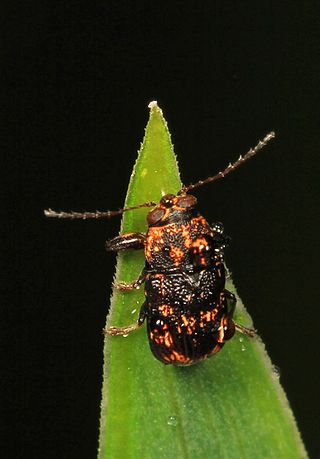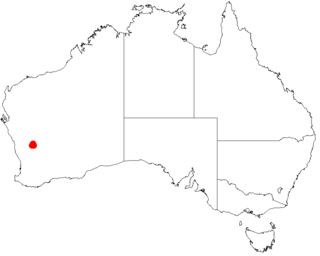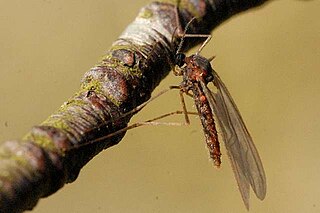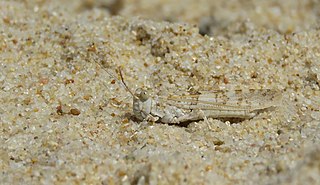
Pallopteridae is a family of flies. The various species are collectively called flutter-wing flies, trembling-wing, or waving-wing flies, because of the striking vibration of the wings in many species. Over 70 species in about 15 genera are found in the temperate regions of the Northern and Southern Hemispheres.

Pachybrachis is a genus of scriptured leaf beetles in the family Chrysomelidae. There are at least 220 described species in Pachybrachis.

The Encyclopedia of Life (EOL) is a free, online encyclopedia intended to document all of the 1.9 million living species known to science. It aggregates content to form "pages" for every known species. Content is compiled from existing trusted databases which are curated by experts and it calls on the assistance of non-experts throughout the world. It includes video, sound, images, graphics, information on characteristics, as well as text. In addition, the Encyclopedia incorporates species-related content from the Biodiversity Heritage Library, which digitizes millions of pages of printed literature from the world's major natural history libraries. The BHL digital content is indexed with the names of organisms using taxonomic indexing software developed by the Global Names project. The EOL project was initially backed by a US$50 million funding commitment, led by the MacArthur Foundation and the Sloan Foundation, who provided US$20 million and US$5 million, respectively. The additional US$25 million came from five cornerstone institutions—the Field Museum, Harvard University, the Marine Biological Laboratory, the Missouri Botanical Garden, and the Smithsonian Institution. The project was initially led by Jim Edwards and the development team by David Patterson. Today, participating institutions and individual donors continue to support EOL through financial contributions.

The spot-crowned euphonia is a species of bird in the family Fringillidae. It is found in Costa Rica and Panama. Its natural habitats are subtropical or tropical moist lowland forest and heavily degraded former forest.

Campiglossa is a genus of fruit flies in the family Tephritidae. There are at least 190 described species in Campiglossa.
Melieria imitans is a species of ulidiid or picture-winged fly in the genus Melieria of the family Ulidiidae.

Sternidius is a genus of flat-faced longhorns in the family of beetles known as Cerambycidae. There are at least 20 described species in Sternidius.

Euphaedra imitans, the equatorial mimic forester, is a butterfly in the family Nymphalidae. It is found in Nigeria, Cameroon, Gabon, the Republic of the Congo, the Democratic Republic of the Congo and western Uganda. The habitat consists of forests.
Aslauga imitans, the imitating aslauga, is a butterfly in the family Lycaenidae. It is found in Ghana, western Cameroon and the Democratic Republic of the Congo.

iNaturalist is an American 501(c)(3) nonprofit social network of naturalists, citizen scientists, and biologists built on the concept of mapping and sharing observations of biodiversity across the globe. iNaturalist may be accessed via its website or from its mobile applications. iNaturalist includes an automated species identification tool, and users further assist each other in identifying organisms from photographs and even sound recordings. As of 9 July 2024, iNaturalist users had contributed approximately 197,660,888 observations of plants, animals, fungi, and other organisms worldwide, and 290,007 users were active in the previous 30 days.
Procrica imitans is a species of moth of the family Tortricidae. It is found in Madagascar.

Acacia imitans, also commonly known as Gibson wattle, is a shrub belonging to the genus Acacia and the subgenus Phyllodineae that is endemic to south western Australia. It is a declared endangered species under the West Australian and Australian Acts, and is on the IUCN Redlist.
Eucalyptus imitans, commonly known as the Illawarra stringybark, is a species of small tree that is endemic to New South Wales. It has rough, stringy, greyish bark on the trunk and larger branches, lance-shaped, elliptic to egg-shaped or curved adult leaves, flower buds in groups of between nine and fifteen, white flowers and hemispherical fruit. It is found on near-coastal tablelands inland from the south coast.

Mycomya cinerascens is a Palearctic species of 'fungus gnats' in the family Mycetophilidae. Mycomya cinerascens is found in forest or wooded areas where the larvae develop in fruiting bodies of Stereum, Thelephora terrestris and Cortinarius sp..Besides fruiting bodies the species has been collected with emergence traps over beech logs and stumps, alder and spruce stumps.
Sciophilinae is a subfamily of fungus gnats. There are at least 40 genera and 340 described species in Sciophilinae.
Macrothemis imitans, the ivory-striped sylph, is a species of skimmer in the dragonfly family Libellulidae. It is found in Central America, North America, and South America.
Mycomya dichaeta is a species of fungus gnats in the family Mycetophilidae.

Mycomya is a genus of fungus gnats in the family Mycetophilidae. There are at least 400 described species in Mycomya.
Tripyloididae is a family of nematodes belonging to the order Araeolaimida.

Sphingonotus imitans, the Algarve sand grasshopper, is a species of band-winged grasshopper in the family Acrididae. It is found on the Iberian Peninsula.











